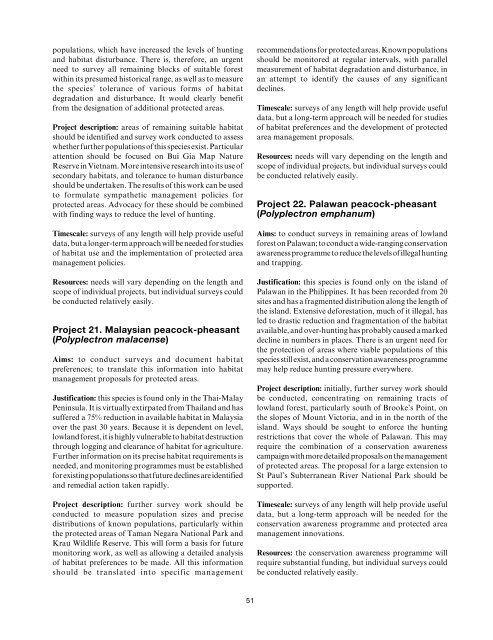Pheasants: Status Survey and Conservation Action Plan ... - IUCN
Pheasants: Status Survey and Conservation Action Plan ... - IUCN
Pheasants: Status Survey and Conservation Action Plan ... - IUCN
Create successful ePaper yourself
Turn your PDF publications into a flip-book with our unique Google optimized e-Paper software.
populations, which have increased the levels of hunting<br />
<strong>and</strong> habitat disturbance. There is, therefore, an urgent<br />
need to survey all remaining blocks of suitable forest<br />
within its presumed historical range, as well as to measure<br />
the species’ tolerance of various forms of habitat<br />
degradation <strong>and</strong> disturbance. It would clearly benefit<br />
from the designation of additional protected areas.<br />
Project description: areas of remaining suitable habitat<br />
should be identified <strong>and</strong> survey work conducted to assess<br />
whether further populations of this species exist. Particular<br />
attention should be focused on Bui Gia Map Nature<br />
Reserve in Vietnam. More intensive research into its use of<br />
secondary habitats, <strong>and</strong> tolerance to human disturbance<br />
should be undertaken. The results of this work can be used<br />
to formulate sympathetic management policies for<br />
protected areas. Advocacy for these should be combined<br />
with finding ways to reduce the level of hunting.<br />
Timescale: surveys of any length will help provide useful<br />
data, but a longer-term approach will be needed for studies<br />
of habitat use <strong>and</strong> the implementation of protected area<br />
management policies.<br />
Resources: needs will vary depending on the length <strong>and</strong><br />
scope of individual projects, but individual surveys could<br />
be conducted relatively easily.<br />
Project 21. Malaysian peacock-pheasant<br />
(Polyplectron malacense)<br />
Aims: to conduct surveys <strong>and</strong> document habitat<br />
preferences; to translate this information into habitat<br />
management proposals for protected areas.<br />
Justification: this species is found only in the Thai-Malay<br />
Peninsula. It is virtually extirpated from Thail<strong>and</strong> <strong>and</strong> has<br />
suffered a 75% reduction in available habitat in Malaysia<br />
over the past 30 years. Because it is dependent on level,<br />
lowl<strong>and</strong> forest, it is highly vulnerable to habitat destruction<br />
through logging <strong>and</strong> clearance of habitat for agriculture.<br />
Further information on its precise habitat requirements is<br />
needed, <strong>and</strong> monitoring programmes must be established<br />
for existing populations so that future declines are identified<br />
<strong>and</strong> remedial action taken rapidly.<br />
Project description: further survey work should be<br />
conducted to measure population sizes <strong>and</strong> precise<br />
distributions of known populations, particularly within<br />
the protected areas of Taman Negara National Park <strong>and</strong><br />
Krau Wildlife Reserve. This will form a basis for future<br />
monitoring work, as well as allowing a detailed analysis<br />
of habitat preferences to be made. All this information<br />
should be translated into specific management<br />
recommendations for protected areas. Known populations<br />
should be monitored at regular intervals, with parallel<br />
measurement of habitat degradation <strong>and</strong> disturbance, in<br />
an attempt to identify the causes of any significant<br />
declines.<br />
Timescale: surveys of any length will help provide useful<br />
data, but a long-term approach will be needed for studies<br />
of habitat preferences <strong>and</strong> the development of protected<br />
area management proposals.<br />
Resources: needs will vary depending on the length <strong>and</strong><br />
scope of individual projects, but individual surveys could<br />
be conducted relatively easily.<br />
Project 22. Palawan peacock-pheasant<br />
(Polyplectron emphanum)<br />
Aims: to conduct surveys in remaining areas of lowl<strong>and</strong><br />
forest on Palawan; to conduct a wide-ranging conservation<br />
awareness programme to reduce the levels of illegal hunting<br />
<strong>and</strong> trapping.<br />
Justification: this species is found only on the isl<strong>and</strong> of<br />
Palawan in the Philippines. It has been recorded from 20<br />
sites <strong>and</strong> has a fragmented distribution along the length of<br />
the isl<strong>and</strong>. Extensive deforestation, much of it illegal, has<br />
led to drastic reduction <strong>and</strong> fragmentation of the habitat<br />
available, <strong>and</strong> over-hunting has probably caused a marked<br />
decline in numbers in places. There is an urgent need for<br />
the protection of areas where viable populations of this<br />
species still exist, <strong>and</strong> a conservation awareness programme<br />
may help reduce hunting pressure everywhere.<br />
Project description: initially, further survey work should<br />
be conducted, concentrating on remaining tracts of<br />
lowl<strong>and</strong> forest, particularly south of Brooke’s Point, on<br />
the slopes of Mount Victoria, <strong>and</strong> in in the north of the<br />
isl<strong>and</strong>. Ways should be sought to enforce the hunting<br />
restrictions that cover the whole of Palawan. This may<br />
require the combination of a conservation awareness<br />
campaign with more detailed proposals on the management<br />
of protected areas. The proposal for a large extension to<br />
St Paul’s Subterranean River National Park should be<br />
supported.<br />
Timescale: surveys of any length will help provide useful<br />
data, but a long-term approach will be needed for the<br />
conservation awareness programme <strong>and</strong> protected area<br />
management innovations.<br />
Resources: the conservation awareness programme will<br />
require substantial funding, but individual surveys could<br />
be conducted relatively easily.<br />
51
















